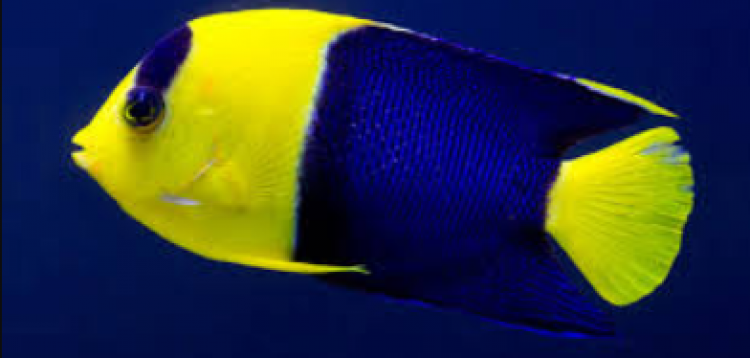- Name:
Spotbreast Angelfish
(View AKA's) - Family: Pomacanthidae
- Species: Angel Large
- Scientific Name: Genicanthus melanospilos


General info about Spotbreast Angelfish
With a highly-flared tail, the Spotbreast Angelfish is one of the few angelfish to exhibit dramatic sexual dimorphism. The female is yellow dorsally, and light blue ventrally. The caudal fin is marine-blue highlighted by a dark, blue-black edging on the top and bottom. The male is marked with a series of vertical red stripes covering the entire pale colored body. The tail of the male is forked and is yellow with blue edges. A large tank with lots of hiding places and live rock for grazing will offer an environment in which to thrive. An exception to most angelfish, the Blackspot Angelfish will make a good reef dweller, and will not nip at stony and soft corals (sessile invertebrates). It is also more peaceful and may be kept as a mated pair, or in schools. Fish of the genus Genicanthus are the only zooplanktivores among the angelfish.
Spotbreast Angelfish Diet & Nutrition
Spotbreast Angelfish are omnivores that prefers to feed on diatoms and filamentous algae in captivity. This angelfish may also be fed with a variety of diet which consists of meaty fare and marine algae-based food, such as fresh shrimp and frozen silversides, frozen brine and mysis shrimp, angelfish preparations, nori, enriched flakes, or pellets containing spirulina.
Determining Sex of Spotbreast Angelfish
The Spotbreast Angelfish are protogynous hermaphrodites, which means that the fish start its life as a female and changes into male when the need arises especially when there is a lack of dominant male.
Male Spotbreast Angelfish are differentiated by their coloration and pattern from the female individual. The male is covered with thin, dark vertical bands that cover the body from head to the dorsal and anal fins, which is followed by a yellow banded area at the base of the tail. Females have a yellow topline that fades into a white body with the top and bottom of the tail being marked by black bars with hints of blue.
Breeding & Spawning Spotbreast Angelfish
Mal Spotbreast Angelfish start their courting ritual by a number of fin movements. The male roll on its side or back in front of the female and tremble or quiver their caudal fin. If successful, he continues the mating ritual which usually occurs at dusk to sunset. Afterwards, the male's entire body will vibrate or quiver excitedly when positioned alongside the female. The female will then extend her fins as encouragement. The male will then nuzzle its head near the rear of the female, both will roll on their sides and release their gametes into the water column.
Common Diseases with Spotbreast Angelfish
Spotbreast angelfish are relatively hardly aquarium fishes, however if tank is not maintained at optimum conditions they will be susceptible to diseases that captive saltwater environment offers. Disease include White Spot Disease caused by Cryptocaryon irritans which causes scratching and white dots on the fish which results in the fish suffocating from these parasites blocking the gills from providing oxygen. Another common disease is Marine Velvet caused by Oodinium ocellatum which results to a peppery coating giving a yellow to light brown "dust" on body, clamped fins, respiratory distress (breathing hard as seen as frequent or quick gill movements), cloudiness of eyes, glancing off decor or substrate, and possible weight loss.
Spotbreast Angelfish Origin
This angelfish species can be found from the Indo-Malayan region to the southwestern Pacific Ocean and from the Ryukyu Islands to New Caledonia and Fiji.
Caution with Spotbreast Angelfish
Spotbreast angelfishes are relatively friendly tank dwellers, but it may chase after small peaceful planktivores or get harassed by other planktivores. These angelfishes should not be housed in tanks with aggressive fish to avoid being dominated by large aggressors such as triggerfish, large angelfish, and most surgeonfish. Suggested tankmates include clownfish, blennies, gobies, chromis, butterflyfish, small lionfish, and eels.
They are also known to jump out of the aquaria, so lids are necessary to prevent it from doing so.
Acclimating Spotbreast Angelfish
This species revels in swimming and requires an aquarium with ample space of at least 125 gallons. This species should have ample hiding places and live rock for grazing. It is suggested to provide an area in the tank with strong water movement within the day. They are best kept in moderately lit aquariums to mimic their natural habitat.
Original Detail
| Name | Species | Family | Scientific Name | More Detail | Added by |
|---|---|---|---|---|---|
| Spotbreast Angelfish | Angel Large | Pomacanthidae | Genicanthus melanospilos | With a highly-flared tail, the Spotbreast Angelfish is one of the few angelfish to exhibit dramatic sexual dimorphism. The female is yellow dorsally, and light blue ventrally. The caudal fin is marine-blue highlighted by a dark, blue-black edging on the top and bottom. The male is marked with a series of vertical red stripes covering the entire pale colored body. The tail of the male is forked and is yellow with blue edges. A large tank with lots of hiding places and live rock for grazing will offer an environment in which to thrive. An exception to most angelfish, the Blackspot Angelfish will make a good reef dweller, and will not nip at stony and soft corals (sessile invertebrates). It is also more peaceful and may be kept as a mated pair, or in schools. Fish of the genus Genicanthus are the only zooplanktivores among the angelfish. |
PalaciosAn |



